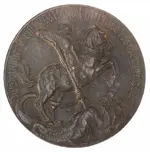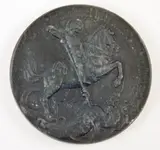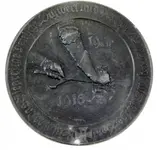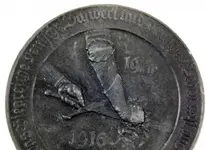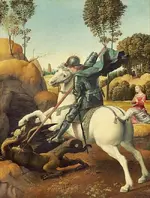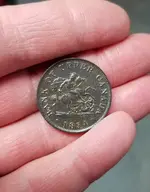It's St Michael, rather than St George and yes, it is German, since he is their patron saint. Essentially this is a patriotic medal designed to give conviction that Germany would win the First World War with divine support.
There’s an identical one in the collection of the Imperial War Museum in London, although it’s not pictured on their website. The collection record is as follows:
Object description
Obverse design: St Michael in full armour, on horseback facing right, driving his lance into a monster which has the body, long tail and wings of a dragon and eight different animal heads - those of a cock, bear, lion, dog, serpent, monkey, sheep and donkey (see Notes). Obverse text: “Du Deutscher Geist St + Michael hilf uns das Gewürm Zertreten” (embossed Gothic script).
Reverse design: sword, held by a pair of hands wearing fluted Gothic armour gauntlets. The left hand clasps the hilt, the right wipes the blade with a laurel branch. Above the sword the date “1914” and below “1916”. At the base of design a small Iron Cross. Reverse text: “Rein blieb Das Siegreiche Deutsche Schwert und Deutsches Leben reist aus blutiger Saat” (embossed Gothic script).
Label
German First World War medal by the unidentified 'E.T.' [the medal has those initials as a signature] invoking, by means of powerful Gothic imagery, the inspiration and support of the patron saint, St Michael in Germany's unequal struggle against the Allied powers. The enemies are depicted as the grotesque heads of a fearsome dragon and may be identified as follows: cock (France), bear (Russia), lion (England), dog (Belgium), serpent (Italy), monkey (Japan), sheep (Serbia), donkey (pro-Allied neutral). The obverse text is translated as “You German genius St Michael help us to crush the reptiles” and gruesome reverse text as “The victorious German sword remained pure and German life ripens from seed soaked in blood”.
Seemingly, they were still making them to stir up some hope of victory, even after the tide turned against them, since there is an almost identical one in the Royal Greenwich Museum in London, but with the dates as 1914-1918 rather than 1914-1916. These pictures from their website:
